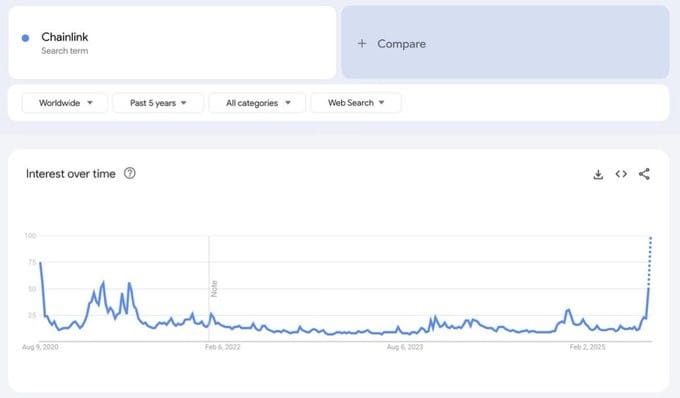The price of Chainlink (LINK) has maintained a gain of over 20% in the past 7 days, standing out amid a strong downturn in altcoins.
Analysts believe this token can withstand the current trend, with forecasts supported by steady adoption rates, expectations for reserve updates, and increasing public interest.
LINK price faces a significant correction
Notably, Chainlink, the 14th largest cryptocurrency by market value, traded at a high of $23.41 on August 14, 2025. At the time of writing, this token has dropped to $22.49, losing 6% in the past 24 hours. Nevertheless, it still maintains a strong increase of 39.3% over the past month.
This price surge occurs as many altcoins also rise in the previous trading session, with traders seeking projects tied to blockchain infrastructure.
Market data shows that Chainlink accounts for 84% of the oracle market share on Ethereum. It also secures more than $84 billion in decentralized finance (DeFi) platforms.
Oracles are systems that bring real-world data onto the blockchain, and with the current numbers, Chainlink has become one of the most widely used networks in this field.
In a recent post on X, market analyst Miles Deutscher described LINK as one of the best large-cap options in this market cycle.
Miles Deutscher points out that major financial corporations like SWIFT, JPMorgan, and Mastercard have previously collaborated with Chainlink to connect blockchain systems with traditional finance. This activity shows that the project has become a bridge between different areas of the financial world.
Why could a breakout occur?
Technically, the price of LINK has surpassed the resistance level of $20 on the weekly chart. This level has served as a barrier for many years. Traders see this move as a signal that the token could continue to rise if buying pressure persists.
How Chainlink manages its token supply is also seen as a factor that could help drive prices.
The network earns revenue from transaction fees on blockchain networks and from agreements with private chains operated by businesses. All this revenue is converted into LINK tokens and added to the Chainlink Reserve. According to the update, this means there is always regular activity buying LINK on the open market.
Another part of the system is staking, where holders lock their LINK to help secure the network. In return, they receive an annual yield of about 4.32% (APR). This mechanism reduces the number of tokens in circulation, lowering supply.
Supporters believe that as acceptance levels increase, additional demand coupled with decreasing supply could drive prices up over time.
This operation creates a stable link between service usage and token purchasing activity. More users mean more fees, more LINK purchases, and a safer network.
Traders believe this cycle could continue to support prices if interest in Chainlink's services continues to grow.
Update on Chainlink Reserve and increasing public interest
Investors are also monitoring news about Chainlink Reserve. Market commentator Rick Barber stated that many are predicting a deposit or update within the next 24 hours.
This reserve fund was initially valued at approximately $1.6 million and held 65,552 LINK, with an average purchase price of $16.83 per token.
Notably, data from Google indicates that online interest in Chainlink has surged significantly.
In a post on X, Chris Barrett — a prominent member of the community — shared data from Google Trends showing a marked increase in Chainlink searches globally.

An increasing number of people searching for Chainlink online is a sign that awareness of this token and its functionality is on the rise.
Notably, LINK's recent price surge stems from more active market activity, significant price increases, along with growing interest from investors and the public.
It is clear that reaching the $40 mark will depend on whether these trends can hold, and whether more people start using Chainlink's services and accumulating LINK.
